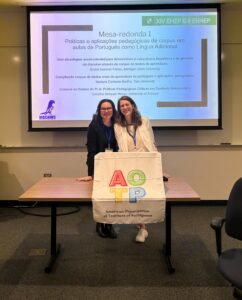Moving beyond banning AI in language classes: How ChatGPT can be used to promote digital literacy
Presenters
- Dr. Charlene Polio (people.cal.msu.edu/polio/)
- Dr. Fred Poole (maflt.marcom.cal.msu.edu/frederick-poole)
How are you using ChatGPT in language teaching? Do you ban it or take advantage of it?
On Friday September 22nd Fred Poole and Charlene Polio will be giving a presentation on promoting digital literacy around ChatGPT in the L2 classroom. This presentation covers recent trends, ethical questions, and a range of recommended activities. Below is a brief summary of the presentation.
Summary of Talk
Large language models like ChatGPT greatly enhance the capabilities of Chatbots. With these new affordances comes a lot of excitement around the uses of ChatGPT as a potential language learning partner, material generator, and/or language tutor. Yet at the same time, there is a lot of fear about the implications of bringing ChatGPT into the classroom. Will cheating become more difficult to spot? Is writing becoming obsolete? What does authorship look like in this new AI world?
In this presentation we argued that many of these exciting possibilities, as well as fears, can be addressed (or at least acknowledged) if we, as language teachers, focus on the promotion of digital literacies in our L2 classrooms. Digital literacies are a set of language and literacy skills needed to function in a digital society. In the late 90’s and early 2000’s they were categorized as basic computer skills, the ability to find information on the internet, creating and editing multimedia content, and effectively communicating via different communication tools (Warschauer, 1998). However, in recent years with rapid development of technology, these skills have become more nuanced. Reinhardt and Thorne (2020) note that in contrast to 20 years ago, students today now come into the classroom with already established dispositions towards technology. Communication is not limited to text or voice, but include multitude of modalities and hybrid modalities. Collaborative reading and writing are now commonplace and also require a specific knowledge and skill set to accomplish successfully. Additionally, with so much content and authorship on the web, learners must be more adept at verifying information than ever before. In this presentation, we note that ChatGPT is simply the latest development that will require instructional attention.
Specifically, we argued that to use ChatGPT effectively and responsibly, language learners must have the following knowledge and skill sets:
- A basic understanding of how ChatGPT generates text.
- A basic understanding of how ChatGPT was trained and what it’s source material is comprised of (e.g. 90% English).
- Able to identify tasks that are more or less suited to ChatGPT’s capabilities.
- Able to write effective prompts to achieve goals.
- Work iteratively to identify effective prompts.
- Know how to use ChatGPT as a language learning resource/tool.
- Able to identify what constitutes as ‘cheating’ vs what is supporting/scaffolding.
- Know how to cite and acknowledge ChatGPT to promote transparency around its uses.
These are the core areas that we focused on. Surely this list will evolve as we use and learn more about the tool. Below are a list of activities for the foreign language classroom that we believe help promote these skills. Though we also acknowledge that whenever ChatGPT is integrated into the language classroom it is likely that learners are developing digital literacies around the tool at some level.
Sample Activities
Comparison Writing – Students write a text and then compare how ChatGPT writes the text. In this task learners are not only being asked to draw attention to their own writing and areas that they may be able to improve on, but they are implicitly analyzing how well ChatGPT is performing a task in their target language.
Comparing Revision – In this task learners are asked to first write a text and then attempt to revise it themselves. Next, they submit their original text and ask ChatGPT to revise it or improve it. Then learners will compare the revisions. What advice did ChatGPT offer and what did the learner focus their attention on. Final products would include a submission of the original article, the revised version, the ChatGPT revision, and the final draft. Illustrating one’s process helps support transparency around the use of the tool.
Prompting for Pragmatics – An area that ChatGPT tends to struggle with is acknowledging cultural pragmatic preferences. This is largely because these preferences tend to be very individualized. When writing emails there is a large number of factors that can contribute to our writing styles. We might consider the power dynamics between the writer and receiver, the relationship between those two, the content being discussed, among many other factors. Each of these elements will impact how language is used to complete a task within an email. While we can provide ChatGPT with more details regarding the email, it will likely not achieve the feel and authenticity that we are looking for. Having language learners prompt ChatGPT to write an email to someone and then analyze how effective it was is a great way to learn about the limitations of ChatGPT while also promoting pragmatic knowledge among language learners.
Picking Prompts – Another task we suggested is providing language learners with three different prompts for one task. Then asking learners to identify which prompt performed better and why. As a follow-up task, learners could be asked to create their own prompt to improve on three that were provided to them. A key skill as we note above is understanding that results from ChatGPT will only be as good as one’s prompts and thus learners should be in the habit of trying multiple prompts to accomplish their targeted task.
Scaffolding the Writing Process – ChatGPT can also be used to scaffold the writing process. Often times getting started can be the most difficult part. We can teach language learners how to ask ChatGPT for starter sentences, a list of most useful words and phrases, or a list of common themes around a particular topic. Tasks like these help learners see how ChatGPT can be used as a language learning resource or tool rather than as a way to circumvent writing homework.
Analyzing Writing –We can ask ChatGPT to identify errors, repetitive language, or areas where content is writing. In other words, we can have our learners use ChatGPT to first identify areas that need work, before submitting a final draft. Again, this is a great way to illustrate how ChatGPT can promote learning rather than replace it. Additionally, it will likely help learners draw attention to shortcomings in their writing.
Feedback from Rubrics – Finally, we demonstrated how language learners can upload a rubric that was provided by a teacher and then ask ChatGPT to analyze their writing according to the rubric. This is not super accurate at the moment, but it is nice way to get students thinking about how their writing aligns or fails to align with the guidelines established for an assignment.
Resources
This first link provides a list of best practices for prompting ChatGPT. This is a great place to start if you want to learn how to get better results from ChatGPT.
Best Practices – https://platform.openai.com/docs/guides/gpt-best-practices
The ChatGPT Cookbook has a list of prompting ideas that can provide a broad overview of how ChatGPT is being used in a variety of fields.
ChatGPT Cookbook – https://cookbook.openai.com/
Finally, if you are looking for more advance use-cases of ChatGPT, this link has a number of tutorials for more advance usecases.
Tutorials – https://platform.openai.com/docs/tutorials
Presentation Slides



